Unit - 1
Chain and Compass Traversing
A traverse is a chain of linked traces whose lengths and guidelines are to be measured and the system of surveying to locate such measurements is called traversing.
In general, chains are used to degree period and compass or theodolite are used to degree the course of traverse traces.
The sorts of traverse and strategies of traversing are mentioned on this article.
Traversing is that sort of survey wherein some of linked survey traces shape the framework and the guidelines and lengths of the survey traces are measured with the assist of an attitude measuring tool and tape or chain respectively.
Classification:
There are kinds of traverse surveying.
They are:
Closed traverse:
When the traces shape a circuit which results up on the beginning point, it's far called a closed traverse.
Open traverse:
When the traces shape a circuit ends some other place besides beginning point, it's far stated to be an open traverse.
Suitability The closed traverse is appropriate for finding the limits of lakes, woods, and many others and for a survey of big areas.
The open traverse is appropriate for surveying an extended slender strip of land as required for an avenue of the canal or the coastline. Methods of Traversing There are numerous techniques of traversing, relying at the contraptions utilized in figuring out the relative guidelines of the traverse traces.
The following are the most important techniques:
Chain traversing Chain and compass traversing
Transit kind traversing
a) By speedy needle approach
b) By size of angles among the traces
Plane desk traversing
Brief descriptions of those traverse surveying techniques are given below.
Chain Traversing
The approach wherein the entire paintings is carried out with chain and tape is referred to as chain traversing.
No attitude size is used and the guidelines of the traces are constant totally with the aid of using linear measurements
Angles constant with the aid of using linear or tie measurements are called chain angles.
The approach is mistaken for correct paintings and is commonly used if an attitude measuring contraptions which include a compass, sextant or theodolite is available.
Chain and Compass
Traversing In chain and compass traversing, the magnetic bearings of the survey traces are measured with the aid of using a compass and the lengths of the traces are measured both with a sequence and with a tape.
The path of the magnetic meridian is set up at every traverse station independently. The approach is likewise called a tree or free needle approach.
Traversing with the aid of using Fast Needle Method
The approach wherein the magnetic bearings of traverse traces are measured with the aid of using a theodolite equipped with s compass is referred to as traversing with the aid of using speedy needle approach.
The path of the magnetic meridian isn't set up at every station however instead, the magnetic bearings of the traces are measured with a reference in order that path of the magnetic meridian set up at the primary station.
There are 3 techniques of watching the bearings of traces with the aid of using speedy needle approach.
Direct approach with transiting, direct approach without transiting, Back bearing approach.
Traversing By Direct Observation Of Angles
In this approach, the angles among the traces are immediately measured with the aid of using a theodolite and the magnetic bearing of different traces may be calculated on this approach.
The angles measured at exceptional stations can be both
Included Angles and Deflection Angles
Traversing with the aid of using Included Angle
A covered attitude at a station is both of the 2 angles shaped by survey traces assembly there and those angles must be measured clockwise.
The approach is composed absolutely in measuring every attitude immediately from an again sight at the previous station.
The angled will also be measured with the aid of using repetition. The angles measured from the again station can be indoors or outside relying at the path of development.
Traversing by included angle
In Fig (a) the path of development is counter-clockwise and so the angles measured clockwise are the indoors attitude. In Fig (a) the path of development is clockwise and so the angles measured clockwise are the outside attitude.
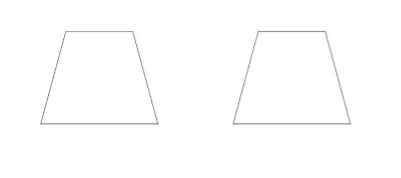
Traverse with the aid of using Deflection Angles
A deflection attitude is an attitude wherein a survey line makes with the prolongation of the previous line. It is particular as right (R) or left (L) as it's far measured clockwise or anti-clockwise from the prolongation of the preceding line. This sort of traversing is extra appropriate for the survey of roads, railways, pipe-traces, and many others wherein the survey traces make small deflection angles.
Principles of survey:
Surveying is largely carried out for measuring the linear parameters in addition to the angular parameters for the established order of factors by using which the plans and maps may be prepared. It makes use of an extensive type of equipment and system.
Some of the critical system utilized in surveying consists of theodolite, compass, auto-stage, chains, and tapes, leveling staff, and many others. Surveying is the maximum critical department of civil engineering earlier than and after all of the civil engineering works consisting of designing and creation of roads, buildings, bridges, irrigation, and water delivery systems, and many others. It essentially gives the primary framework for the conception, design, and execution of the development works. The manner of surveying consists of each fieldwork and workplace paintings.
In general, Surveying is primarily based totally upon some of principles (or guidelines) which may be indexed as follows:
a. Working from Whole to Part
b. Location of Point with the aid of using Measurement from Two Points of Reference
c. Consistency of Work
d. Independent Check
e. Accuracy Required
a. Working from Whole to Part
As the call itself implies, the survey paintings need to be finished from entire to component. This method that after a place is to be surveyed, first of all, a device of manipulate factors is installed such that it covers the whole region with a better diploma of precision.
After this, the minor manipulate factors and information are similarly installed with a lesser diploma of precision.
The principal concept of this precept is to save you the undue accumulation of mistakes and thereby manipulate and localize the minor mistakes. If the survey is finished from component to entire, the magnitudes of mistakes gathered could be very high.
Example: This precept is crucial in International Boundary Locating, Property Boundary Locating, and many others.
b. Location of Point with the aid of using Measurement
From Two Points of Reference
On the idea of this precept, the relative function of the favored factors to be surveyed need to be placed with the aid of using taking the dimension from at the least two (ideally three) factors of reference, such that the placement of the reference factors have already been constant previously.
c. Consistency of Work
Another critical precept of surveying is the consistency of paintings. It need to be cited that preserving consistency with inside the technique, device, studying and noting observations, and many others enables to benefit the favored stage of accuracy.
d. Independent Check
Independent take a look at is the essential precept this is normally followed to save you blunders with inside the survey paintings. According to this precept, each dimension this is taken with inside the area need to be re-checked with the aid of using adopting an appropriate technique of unbiased area assessments and observations in order that any mistake if gift isn't surpassed without notice.
e. Accuracy
Required According to this precept of surveying; the right technique and device need to be used for the survey paintings on the idea of the diploma of accuracy required.
Tape survey:
Today, measuring tapes made for sewing are crafted from fiberglass, which does now not tear or stretch as without issues.
Measuring tapes designed for carpentry or introduction often use a stiff, curved metallic ribbon that may live stiff and without delay at the same time as extended, but retracts proper right into a coil for accessible storage.
This type of tape diploma should have a floating tang or hook on the forestall to beneficial aid measuring.
The tang is established to the tape with unfastened rivets through oval holes, and might by skip a distance identical to its thickness, to provide every inside and outside measurements which may be accurate.
A tape diploma of 25 or perhaps a hundred feet can wind proper right into a fantastically small container. The self-marking tape diploma allows the individual an accurate one hand diploma.
A tape diploma or measuring tape is a flexible ruler used to diploma period or distance. It consists of a ribbon of fabric, plastic, fiber glass, or metal strip with linear length markings.
It is a now no longer unusual place measuring tool. Its format allows for a diploma of first-rate length to be without issues carried in pocket or toolkit and lets in one to diploma spherical curves or corners.
TAPING:
Taping is the linear size of the horizontal distance among factors the usage of a surveyor's tape. Observation of horizontal distances through taping is composed of. Making use of the recognized duration of a graduated tape at once to line a. Range of times.
Invar, an alloy of nickel and metal having a totally low coefficient of enlargement, resolved the thermal enlargement trouble related to the usage of different steel rods and tapes for distance size.
With the discovery of invar, tapes and wires have become possible for measuring distances.
Keeping this in consideration, what are the kinds of tapes in surveying? There are five kinds of tapes to be had in surveying for linear measurements and they're as follows:
- Linen Tape.
- Woven Metallic Tape.
- Steel Tape.
- Linen Tape.
What is the reason of taping?
Athletic taping is the procedure of making use of tape at once to the pores and skin which will preserve a strong role of bones and muscular tissues throughout athletic activity.
Taping is typically used to assist get over overuse and different injuries.
Cross Staff Survey:
The cross-workforce is a device used to degree angles and altitudes, which include a trigonometrically graduated workforce and one or greater perpendicular vanes shifting over it.
First defined in approximately 1342 through the Jewish logician and scientist Levi ben Garson and firstly used for astronomical and surveying purposes, it have become a mariner's navigational device with inside the sixteenth century (additionally recognized as 'ballast Ella', 'Jacob's workforce ' or 'fore-workforce').
The device became especially used for locating the range through measuring the altitude of the polar big name and for measuring the altitude of the solar. In the latter use, the observer needed to face the solar and this inconvenience brought about the improvement of the back-workforce.
To degree the altitude of a celestial body, the eye-quit of the workforce became positioned close to the observer's eye and the opposite quit 1/2 of manner among the horizon and the celestial body.
The altitude should then be examine off the workforce.
This form of survey is undertaken to discover barriers of a subject or a subject or plat and determinations of its location.
Principle:
The precept of the survey is to divide the given location in to no of proper angled triangles and trapezoids and to calculate and plot the regions of triangles and trapezoids.
Instruments/Material Required:
Two Chains, arrows taps, ranging rods, move-body of workers and drawing material
Two chains are normally supplied one for measuring distance alongside the chain line and different for measuring the offsets.
The move body of workers is used to set out the perpendicular instructions for offsets. In this survey, the bottom line runs via the middle of the location, in order that the offsets are left or proper aspect of final analysis are pretty same.
To test accuracy duration of the boundary strains will also be measured. After the sector paintings is over, the survey is plotted to an appropriate scale.
Calculations of Field Area:
By this approach of survey, the sector as divided in to proper angled triangles and trapezoids are calculated as under:
- Area of proper -angled triangle = ½ base x Height.
- Area of trapezoid= sum of parallel sides/2 x Height.
Add the regions of all of the triangles & trapezoids and sum is same to the entire of a subject.
Construction, use and testing of optical square:
The optical rectangular makes use of a pent prism to mirror and refract a beam or sighting ninety degrees, it's far utilized in pairs in surveying and in a novel block in metrology.
In optical rectangular A Horizon glass is located at a perspective of 120° with the horizon sight.
The Index glass is located at a perspective of 105° with the Index sight. Angle among Index glass and Horizon glass is 45°.
An optical rectangular is beneficial in turning the road of sight through ninety° from its unique course.
Many optical contraptions, in particular microscopes, have this requirement. An Optical rectangular is are basically a pentagonal prism (pent prism).
Regardless of the perspective at which the incident beam moves the face of the prism, it's far grew to become through ninety° through inner reflection. Unlike a flat reflect, the accuracy of a pent prism will now no longer be stricken by the mistakes gift with inside the mounting arrangement.
From the above schematic diagram, a reflect is stored at an perspective of 45° with appreciate to the incident ray of mild in order that the pondered ray may be at an perspective of ninety° with appreciate to the incident ray.
These mistakes in aggregate might also additionally also be more than the work piece suaveness blunders.
This hassle can be conquer through the use of an optical rectangular. The above schematic diagram illustrates the optical course through an optical rectangular.
The incident ray is pondered internally from faces and emerges from the rectangular at precisely ninety° to the incident mild.
This is a first rate property. Any moderate deviation or misalignment of the prism does now no longer have an effect on the proper perspective motion of the mild ray.

Optical squares are of types.
One kind is outfitted into contraptions like telescopes, in which an optical rectangular is factory-suited for make certain that the road of sight is perpendicular to the vertex.
The 2nd kind comes with the vital attachments for making modifications to the road of sight. This flexibility lets in optical squares for use in some of programs in metrology.
The above schematic diagram illustrates using optical squares to check the suaveness of device sideways.
The suaveness of the vertical slide way with appreciate to a horizontal slide way or mattress is of maximum significance in device tools.
The take a look at setup calls for an autocollimator, aircraft reflectors, and an optical rectangular. It is vital to take handiest readings, one with the reflector at function A and a 2nd at function B, the optical rectangular being set down on the intersection of the 2 surfaces while the analyzing at B is taken.
The distinction among the 2 readings is the suaveness blunders.
Use of the Optical Square
- This is a tool 2 in. Diameter through 3/four in.
- F is a tumbler 1/2 of silvered and 1/2 of plain the junction line being with inside the aircraft of the tool: G is an entire reflect.
- In the usage of the tool for sighting poles as proven, it'd be held with inside the left hand; with the attention at A, the pole D might be visible via the outlet B and the obvious a part of the glass F;
- The observer being on the factor in which a proper attitude might be measured among D H, E H. Rays of mild from pole E will attain reflect G and be contemplated from there to the silvered a part of glass F and thence to the attention at A,
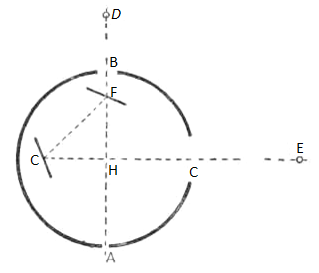
Fig: Optical Square terminologies
- In order that the glass F will appear to be Fig. 2,
- The piece of pole J visible through direct imaginative and prescient being precisely over the piece of pole K visible through reflection.
- If in the usage of the tool the poles do now no longer coincide,
- The station of the observer need to be shifted till they do, or as an opportunity one of the poles need to be shifted.
- If the poles seem to coincide on the junction of the glasses however now no longer to be in a directly line, it'll he because of one of the poles being at a better stage than the other.
Testing of optical square:
Observe the ranging rod at A with optical rectangular stationed at a few intermediate factor C and aligned alongside line AB (Figure (a).
Mark a factor as perpendicular offset at C.
Further, look at the ranging rod at B, despite the fact that closing device stationed at C and aligned alongside AB, and mark the offset factor b.
If the optical rectangular is correctly adjusted then it factors a and b could be coinciding. If this isn't always then, the device calls for adjustment.
The distance abs is bisected at D.
Then CD could be authentic offset. Remain the ranging rod at D. And rotate reflect M2, until photo of A and B, i.e. factor a or b coincides in conjunction with D as depicted in Figure (a).
A technique is repeated until each the observations, via optical rectangular, offer anunmarried offset function D inside region of a and b.
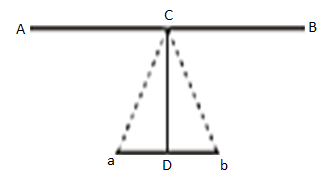
Fig: Testing of optical square
Line Ranger:
Line Ranger is a light-weight tool inclusive of proper-angled isosceles prisms (aircraft mirrors) located one above the opposite and one sight vane such that the surveyor can see the picture shaped at the prism.
The higher prism is movable and may be adjusted even as the decrease prism is fixed.
Diagonals of the prism are silver lined such that they replicate incident ray.
Line Ranger It is an optical tool used for finding a factor on a line and consequently beneficial for ranging.
The diagonals of the prisms are silvered that allows you to replicate the rays. To discover factor C online AB the surveyor holds the tool in hand and stands close to the approximate role of C.
If he isn't precisely online AB, the ranging rods at A and B seem separated as proven
The surveyor movements from side to side at proper angles to the road AB until the snap shots of ranging rods at A and B seem in a unmarried line as proven in
It takes place simplest whilst the optical rectangular is precisely online AB. Thus the favored factor C is placed on the road AB.
Its benefit is it desires simplest one man or woman to range.
The tool need to be every now and then examined via way of means of marking 3 factors in a line and status on center factor gazing the accident of the ranging rods
If the snap shots of the 2 ranging rods do now no longer seem with inside the identical line, one of the prism is adjusted via way of means of working the screw furnished for it.
Key Takeaways:
- Suitability The closed traverse is appropriate for finding the limits of lakes, woods, and many others and for a survey of big areas.
- Angles constant with the aid of using linear or tie measurements are called chain angles.
- In general, Surveying is primarily based totally upon some of principles (or guidelines) which may be indexed as follows:
Compass Traversing:
A compass traverse is a technique of filling in element on a topographic, geologic, or different map. It is a technique of surveying a path along with a stream, path, or the threshold of an outcrop with the aid of a sequence of traverse legs , of every of which the bearing is found through compass and the period measured without delay with inside the field.
It can be defined as a zigzag. The traverse can be closed or open relying on whether or not or now no longer it returns to the beginning point.
A place can be surveyed with the aid of a grid of traverse traces. For many centuries mariners have navigated through a sequence of courses, dictated normally through the wind, the bearing of every route being given through the compass and the period from an estimate of velocity and elapsed time.
The ensuing useless reckoning changed into checked at appropriate periods through astronomical statement or from bearings to acknowledged factors. Many coastlines have been surveyed on this manner, however even though there's no actual report whilst the technique changed into first utilized in land surveying, it seems...
A kind of survey that includes each linear in addition to angular measurements called Compass Traversing.
In Traverse surveying the guidelines of survey traces re constant through angular measurements and now no longer through forming a community of triangles as achieved in chain surveying.
A traverse survey is one wherein framework encompass a sequence of linked traces, the duration and guidelines of which measured with a sequence or tape and angular gadgets respectively.
The habitual of converting and offsetting is similar to in chain surveying. The walking off take a look at traces isn't always necessary.
Types of Traverse
There are commonly types,
Closed Traverse
A traverse stated to close while an entire circuit made i.e. while it returns to the place to begin forming a closed polygon OR while it starts and ends at factors whose positions on plan known.
The paintings might also additionally checked or “balanced”. Suitable for finding bounders of lakes, woods and so on and for the survey of reasonably big area.

Open Traverse
A traverse stated to open or unclosed while it does now no longer shape a closed polygon. It encompass connecting traces extending with inside the equal well-known route and now no longer returning to the place to begin.
Similarly it does now no longer begin and cease as factors whose positions on plan known. It is appropriate for the survey of lengthy slender strip Egg River, coast line, road, and railway and so on.
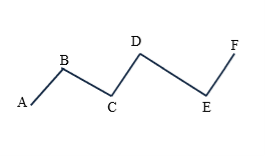
Prismatic and Surveyor's Compass:
Surveyors Compass:
Used with a series while traversing, this device supplied a tremendously brief approach of measuring horizontal guidelines in surveying, however now no longer with the accuracy of a theodolite.
There are essential styles of magnetic compass utilized in surveying, each of that are covered within side the collection - the Surveyor's compass and the Prismatic compass.
The surveyor's compass is typically the bigger and greater correct device, and is typically used on a stand or tripod.
The prismatic compass is usually a small device that is held within side the hand for observing, and is consequently hired for much less correct work.
This surveyor's compass includes a long, thin, pointed needle of magnetized metallic with a small conical-formed bearing of agate cloth on the center.
The stop of this needle which factors north, the north stop, is differentiated from the opposite stop, the south stop, via way of means of a small metallic pin which passes horizontally via the needle close to its north stop.
The agate bearing works on a pointed pivot of tough metallic carried on the center of the low cylindrical metallic container (140mm in diameter).
Attached to the alternative ends of this container are sighting vanes with gradual movement screws and clamps which permit a particular line of sight to be described or laid out.
The device can both be screwed directly to a tripod and continue to be handheld for the reason of measuring magnetic bearings.
The metallic container contains inner it, 3 graduated horizontal circles: pinnacle and decrease circles 0-360 ranges, 1/3 circle in quadrants 0-ninety ranges, with the N and S guidelines diagnosed as 0 factors and the E and W guidelines are labelled as ninety ranges each.
The decrease horizontal circle can examine to three mines immediately at the veneer. The azimuths are typically measured at the pinnacle circle clockwise from north via 360 ranges.
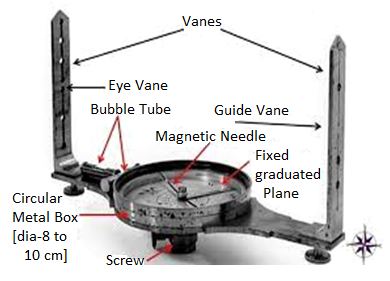
Fig: Surveyors Compass
A disc of glass, becoming on pinnacle of the metallic case, protects the needle and graduated circles. In this device, the needle stays in a set position (the location of the magnetic south to north line), at the same time as the 2 higher graduated circles, collectively with the road of sight, rotate approximately the vertical axis.
While the term 'circus fermenter' changed into constantly used to consult a surveying compass, a general shape of device changed into now no longer set up till the early eighteenth century. Irish and American maker’s produced big numbers of cecum fermenters within side the eighteenth century.
The device changed into greater famous in America than in Britain, and in fact, a whole own circle of relatives of units changed into to increase from the cecum fermenter in America within side the 19th century. There are a few doubts approximately the identification of the inventor of this device however it appears probably too had been Gemma Friseurs within side the first 1/2 of the 16th century.
Prismatic Compass:
A prismatic compass is a navigation and surveying device that's substantially used to discover the bearing of the traversing and blanketed angles among them, waypoints (an endpoint of the course) and direction. Compass surveying is a form of surveying wherein the guidelines of surveying traces are decided with a magnetic compass, and the duration of the surveying traces are measured with a tape or chain or laser variety finder. The compass is commonly used to run a traverse line. The compass calculates bearings of traces with appreciate to magnetic needle. The blanketed angles can then be calculated the usage of appropriate formulation in case of clockwise and anti-clockwise traverse respectively.
The call Prismatic compass is given to it as it basically includes a prism that's used for taking observations greater accurately.
This Prismatic Compass is one of the essential varieties of magnetic compasses covered within side the series for the motive of measuring magnetic bearings, with the alternative being the Surveyor's Compass.
The essential distinction among the 2 units is that the surveyor's compass is generally the bigger and extra correct tool, and is typically used on a stand or tripod.
The prismatic compass however is usually a small tool that is held within side the hand for observing, and is consequently hired at the rougher training of work.
The graduations in this prismatic compass are located on a mild aluminum ring fixed to the needle, and the 0 of the graduations coincides with the south factor of the needle.
The graduations consequently continue to be desk bound with the needle, and the index turns with the sighting vanes. Since the circle is study on the observer's (instead of the targets) cease, the graduations run clockwise from the south cease of the needle while within side the surveyor's compass, the graduations run anti-clockwise from north.
The prism is carried on a mounting which may be moved up and down among slides constant at the out of doors of the case.
The motive of this up-and-down motion is to offer an adjustment for focusing.
The photograph of the graduations is visible through a small round aperture within side the prism mounting, and at once above this aperture is a small V reduce on pinnacle of the mounting, over which the vertical twine within side the front vane can be considered.
When the V reduce, the vertical twine and the station whose bearing is needed are considered in a single line, the bearing is at once study off the graduated arc on the factor at once under the vertical twine.
The rectangular replicate positioned in the front of the ahead vane slides up and down the vane, and is hinged to fold flat over it or to relaxation willing at any perspective with it.
This replicate is used for sun observations, or for viewing any very excessive object, and isn't an everyday becoming to a compass.
The round discs in the front of the again vane are darkish glasses which may be swung in the front of the vane while sun observations are being taken.
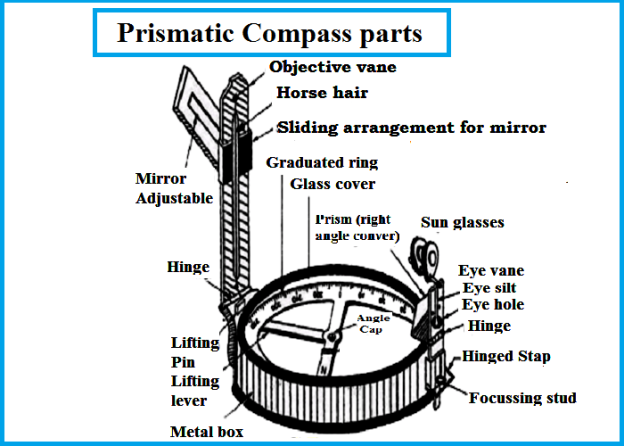
Fig: Prismatic compass

1. True meridian
The line or aircraft passing via the geographical North Pole, geographical South Pole and any point at the floor of the earth, is called the ‘actual meridian’ or ‘geographical meridian’.
The actual meridian at a station is constant. The actual meridians passing via distinct factors at the earth’s floor aren't parallel, however converge toward the poles. But for surveys is small areas, the actual meridians passing via distinct factors are assumed parallel.
The perspective among the actual meridian and a line is called ‘actual bearing’ of the line. It is likewise called the ‘azimuth’.
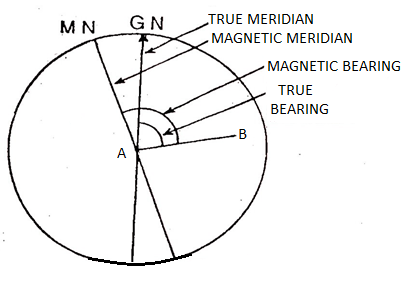
2. Magnetic meridian
When a magnetic needle is suspended freely and balanced properly, unaffected through magnetic substances, it shows a path. This path is called the ‘magnetic meridian’. The perspective among the magnetic meridian and a line is called the ‘magnetic bearing’ or sincerely the ‘bearing’ of the line
Local Attraction:
While compass surveying, the magnetic needle is every so often disturbed from its ordinary function beneath the effect of outside appealing forces. Such a traumatic affect is referred to as neighborhood enchantment. The outside forces are produced through reasserts of neighborhood enchantment which can be contemporary sporting wire (magnetic materials) or metallic gadgets. The time period is likewise used to indicate quantity of deviation of the needle from its ordinary function.
It primarily reasons mistakes in observations whilst surveying and accordingly appropriate strategies are hired to forget about those mistakes Local enchantment is the phenomenon through which the magnetic needle is continuously averted to factor closer to the magnetic north at a place
This is due to the fact that those magnetic compass is encouraged through different magnetic gadgets at that locality together with wires sporting electric powered contemporary, rails, metal and iron structures, metal tapes etc. The prevalence of neighborhood enchantment may be detected through watching the distinction among the fore and again bearings.
If there may be no effect of neighborhood enchantment and different blunders, this distinction may be 180. So we are able to then finish that each stations are loose from neighborhood enchantment.
Elimination of neighborhood enchantment in Compass Surveying Due to neighborhood enchantment extensive quantity of blunders may be arise in compass surveying observations and they may be identical on all of the bearings.
Local enchantment may be minimized the use of following strategies:
Method 1
This technique is primarily based totally at the distinction of fore and again bearings. We already recognize that the distinction among fore and again bearing of a line may be 180˚ if there may be no mistakes in measurement.
So primarily based totally in this blunders loose commentary of bearings, corrections for different strains may be calculated.
However if there may be no bearing has a distinction of 180˚, we are able to calculate the correction from the suggest fee of that bearings which might also additionally have least blunders.
Method 2
This technique is greater quicker technique for making use of correction. This is primarily based totally at the indoors angles of the closed traverse formed.
The indoors angles measured may be accurate on the premise of the reality that those angles aren't suffering from the neighborhood enchantment while the stations are.
So the sum of overall indoors angles for a closed traverse may be (2n-4) 90˚. If there may be any blunders exists each sum will now no longer be identical. The overall blunders may be dispensed the various angles similarly due to the fact identical blunders will arise on every indoors angle. So beginning from the right commentary of bearing which has a distinction in fore and again bearing is 180˚, we are able to calculate all different corrected bearings
Magnetic dip:
- Magnetic dip, dip perspective, or magnetic inclination is the perspective made with the horizontal through the Earth's magnetic subject lines.
- This perspective varies at one of a kind factors at the Earth's surface.
- Positive values of inclination suggest that the magnetic subject of the Earth is pointing downward, into the Earth, on the factor of measurement, and bad values suggest that it's far pointing upward.
- The dip perspective is in precept the perspective made through the needle of a vertically held compass, eleven though in exercise everyday compass needles can be weighted in opposition to dip or can be not able to transport freely in the proper plane.
- The cost may be measured greater reliably with a unique tool generally called a dip circle.
- It is the inclination of magnetic needle of compass with horizontal
- Dip is zero at equator, 90° at poles.
- Dip isn't always constant
- The magnetic dip is described because the perspective made with the horizontal with the aid of using the earth’s magnetic area traces.
- It is likewise called dip perspective or magnetic inclination and become found with the aid of using Georg Hartmann within side the 12 months 1544.
- When the inclination is fantastic it suggests that the earth’s magnetic traces are pointing downward within side the Northern Hemisphere and whilst the inclination is bad it suggests that the earth’s magnetic traces are pointing upward within side the Southern Hemisphere.
- In the 12 months 1581 Robert Norman found a dip circle that is a technique used to degree the dip perspective.
- The different phrases used are isoclinic traces (whilst the contour traces are same on the earth’s surface) and clinic traces (whilst the locus of the factors are having 0 dips).
Inclination:
Magnetic declination is the distinction among the True Meridians and the Magnetic Meridians.
This distinction displays the lean of the earth’s magnetic subject in recognize to its axis of rotation.
Since the magnetic poles and axis of rotation do now no longer precisely coincide, compass needles do now no longer suggest genuine North at maximum web sites within side the northern hemisphere, or genuine south at maximum web sites within side the southern hemisphere.
Most Topographic Maps have a couple of arrows that resemble the arms of a clock within side the decrease left border that suggest the distinction among geographic N and magnetic N for the middle of the place shown.
Aeronautical Charts, to be had at or close to neighborhood airports that provide flight lessons, display a greater whole photo of magnetic declination.
The charts display traces of same magnetic declination referred to as isogonic traces.
Magnetic inclination is the attitude made through a compass needle while the compass is held in a vertical orientation.
Positive values of inclination suggest that the sphere is pointing downward, into the Earth, on the factor of measurement.
Compass traversing adjustment of traverse:
Quadrilateral Traverse Adjustments
A traverse is a survey wherein you have were given occupied each station and measured each mind-set and distance amongst points. An example of a sturdy shape often used for reading deformation, which incorporates on a landslide (Baum and others, 1988
This is wherein all the angles and distances in a quadrilateral are measured over and over and averaged for accuracy. The quadrilateral is then measured at some later date and strain calculated from the extrude in shape of the quadrilateral.
The sum of the interior angles for a quadrilateral must be 360°. Any deviation from that is a diploma of errors. Also, the triangles that make up the quadrilateral must all obey the criminal suggestions of sins and cosines - any deviation is a diploma of errors. Needless to say, each the space measurements or the angles is probably in errors. We moreover have an over-determined system. For example measuring angles and one aspect of a triangle is sufficient to collect the complete triangle (despite the fact that there may be no errors control).
Probably the great method for solving over-determined systems is the strategies of least-squares.
Least Squares Adjustment
An outline of the method of preferred least squares is given within side the subsequent PDF format document (from the G423/523 Course Web pages).
Since we recognize that the quadrilateral must have no errors, and we have got were given glad ourselves that there may be no obvious terrible data in our data set, we can alter the angles and distances just so out shape meets all the geometric criteria.
The most entire adjustment strategies uses least-squares to alter angles and distances so that you make the smallest possible changes
One method for adjusting quadrilaterals is given with the resource of the usage of Smith & Vanes (1987).
Copies of FORTRAN packages from Smith & Vanes are available here: Triangle or Quadrilateral. Note that the packages require ISML routines. An Excel workbook is also available for making the ones changes to a quadrilateral.
Coordinate Adjustment
Simpler techniques of converting traverses are established in plenty of Geology place strategies texts.
A sense of errors in a traverse can be acquired with the resource of the usage of calculating coordinates for each component following the direction of your traverse.
After completing the traverse you need to move returned to the start coordinates, any difference is a diploma of your preferred errors. For a quadrilateral you may perform the following calculations:
From the SE corner, use the mind-set amongst strains from the SE to SW corner and SE to NE corner to calculate the coordinates of the NE corner.
From the NE corner, use the mind-set amongst strains from the NE to SE corner and NE to NW corner to calculate the coordinates of the NE corner.
From the NW corner, use the mind-set amongst strains from the NW to NE corner and NW to SW corner to calculate the coordinates of the SE corner. The difference amongst this calculated coordinate and (0, 0, 0) is your errors of closure.
This closure errors can then be adjusted to zero the usage of each the compass rule or the transit rule. An Excel workbook showing the ones correction strategies is available here.
Compass Rule
In this method the coordinate error is distributed in proportion to the length of traverse lines. The assumption is that the greatest error will come from the longest shots.
- Northing adjustment = Length of traverse line to point / Total length of traverse × Northing closure error
- Easting adjustment = Length of traverse line to point / Total length of traverse × Easting closure error
- Elevation adjustment = Length of traverse line to point / Total length of traverse × Elevation closure error
Transit Rule
In this method, the coordinate error is distributed in proportion to the amount that various coordinates change between points.
- Northing adjustment = Change in Northing for traverse line to point / Sum of absolute values of all changes in northing for all traverse lines × Northing closure error
- Easting adjustment = Change in Northing for traverse line to point / Sum of absolute values of all changes in northing for all traverse lines × Easting closure error
Key Takeaways:
- A kind of survey that includes each linear in addition to angular measurements called Compass Traversing.
- The prismatic compass is usually a small device that is held within side the hand for observing, and is consequently hired for much less correct work.
- The line or aircraft passing via the geographical North Pole, geographical South Pole and any point at the floor of the earth, is called the ‘actual meridian’ or ‘geographical meridian’.
References:
1. Surveying and Levelling by Kanetkar and Kulkarni (Vol.I) Pune Vidhatigrihan Prakashan
2. Surveying and Levelling by Dr. B.C. Punmia (Vol. I & II) Laxmi Pub.
3. Advance Surveying - Total Station, GIS and Remote Sensing by Pearson Education Satheesh Gopi & R. Sathikumar& N. Madhu
Unit - 1
Chain and Compass Traversing
Unit - 1
Chain and Compass Traversing
A traverse is a chain of linked traces whose lengths and guidelines are to be measured and the system of surveying to locate such measurements is called traversing.
In general, chains are used to degree period and compass or theodolite are used to degree the course of traverse traces.
The sorts of traverse and strategies of traversing are mentioned on this article.
Traversing is that sort of survey wherein some of linked survey traces shape the framework and the guidelines and lengths of the survey traces are measured with the assist of an attitude measuring tool and tape or chain respectively.
Classification:
There are kinds of traverse surveying.
They are:
Closed traverse:
When the traces shape a circuit which results up on the beginning point, it's far called a closed traverse.
Open traverse:
When the traces shape a circuit ends some other place besides beginning point, it's far stated to be an open traverse.
Suitability The closed traverse is appropriate for finding the limits of lakes, woods, and many others and for a survey of big areas.
The open traverse is appropriate for surveying an extended slender strip of land as required for an avenue of the canal or the coastline. Methods of Traversing There are numerous techniques of traversing, relying at the contraptions utilized in figuring out the relative guidelines of the traverse traces.
The following are the most important techniques:
Chain traversing Chain and compass traversing
Transit kind traversing
a) By speedy needle approach
b) By size of angles among the traces
Plane desk traversing
Brief descriptions of those traverse surveying techniques are given below.
Chain Traversing
The approach wherein the entire paintings is carried out with chain and tape is referred to as chain traversing.
No attitude size is used and the guidelines of the traces are constant totally with the aid of using linear measurements
Angles constant with the aid of using linear or tie measurements are called chain angles.
The approach is mistaken for correct paintings and is commonly used if an attitude measuring contraptions which include a compass, sextant or theodolite is available.
Chain and Compass
Traversing In chain and compass traversing, the magnetic bearings of the survey traces are measured with the aid of using a compass and the lengths of the traces are measured both with a sequence and with a tape.
The path of the magnetic meridian is set up at every traverse station independently. The approach is likewise called a tree or free needle approach.
Traversing with the aid of using Fast Needle Method
The approach wherein the magnetic bearings of traverse traces are measured with the aid of using a theodolite equipped with s compass is referred to as traversing with the aid of using speedy needle approach.
The path of the magnetic meridian isn't set up at every station however instead, the magnetic bearings of the traces are measured with a reference in order that path of the magnetic meridian set up at the primary station.
There are 3 techniques of watching the bearings of traces with the aid of using speedy needle approach.
Direct approach with transiting, direct approach without transiting, Back bearing approach.
Traversing By Direct Observation Of Angles
In this approach, the angles among the traces are immediately measured with the aid of using a theodolite and the magnetic bearing of different traces may be calculated on this approach.
The angles measured at exceptional stations can be both
Included Angles and Deflection Angles
Traversing with the aid of using Included Angle
A covered attitude at a station is both of the 2 angles shaped by survey traces assembly there and those angles must be measured clockwise.
The approach is composed absolutely in measuring every attitude immediately from an again sight at the previous station.
The angled will also be measured with the aid of using repetition. The angles measured from the again station can be indoors or outside relying at the path of development.
Traversing by included angle
In Fig (a) the path of development is counter-clockwise and so the angles measured clockwise are the indoors attitude. In Fig (a) the path of development is clockwise and so the angles measured clockwise are the outside attitude.
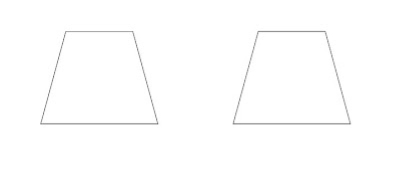
Traverse with the aid of using Deflection Angles
A deflection attitude is an attitude wherein a survey line makes with the prolongation of the previous line. It is particular as right (R) or left (L) as it's far measured clockwise or anti-clockwise from the prolongation of the preceding line. This sort of traversing is extra appropriate for the survey of roads, railways, pipe-traces, and many others wherein the survey traces make small deflection angles.
Principles of survey:
Surveying is largely carried out for measuring the linear parameters in addition to the angular parameters for the established order of factors by using which the plans and maps may be prepared. It makes use of an extensive type of equipment and system.
Some of the critical system utilized in surveying consists of theodolite, compass, auto-stage, chains, and tapes, leveling staff, and many others. Surveying is the maximum critical department of civil engineering earlier than and after all of the civil engineering works consisting of designing and creation of roads, buildings, bridges, irrigation, and water delivery systems, and many others. It essentially gives the primary framework for the conception, design, and execution of the development works. The manner of surveying consists of each fieldwork and workplace paintings.
In general, Surveying is primarily based totally upon some of principles (or guidelines) which may be indexed as follows:
a. Working from Whole to Part
b. Location of Point with the aid of using Measurement from Two Points of Reference
c. Consistency of Work
d. Independent Check
e. Accuracy Required
a. Working from Whole to Part
As the call itself implies, the survey paintings need to be finished from entire to component. This method that after a place is to be surveyed, first of all, a device of manipulate factors is installed such that it covers the whole region with a better diploma of precision.
After this, the minor manipulate factors and information are similarly installed with a lesser diploma of precision.
The principal concept of this precept is to save you the undue accumulation of mistakes and thereby manipulate and localize the minor mistakes. If the survey is finished from component to entire, the magnitudes of mistakes gathered could be very high.
Example: This precept is crucial in International Boundary Locating, Property Boundary Locating, and many others.
b. Location of Point with the aid of using Measurement
From Two Points of Reference
On the idea of this precept, the relative function of the favored factors to be surveyed need to be placed with the aid of using taking the dimension from at the least two (ideally three) factors of reference, such that the placement of the reference factors have already been constant previously.
c. Consistency of Work
Another critical precept of surveying is the consistency of paintings. It need to be cited that preserving consistency with inside the technique, device, studying and noting observations, and many others enables to benefit the favored stage of accuracy.
d. Independent Check
Independent take a look at is the essential precept this is normally followed to save you blunders with inside the survey paintings. According to this precept, each dimension this is taken with inside the area need to be re-checked with the aid of using adopting an appropriate technique of unbiased area assessments and observations in order that any mistake if gift isn't surpassed without notice.
e. Accuracy
Required According to this precept of surveying; the right technique and device need to be used for the survey paintings on the idea of the diploma of accuracy required.
Tape survey:
Today, measuring tapes made for sewing are crafted from fiberglass, which does now not tear or stretch as without issues.
Measuring tapes designed for carpentry or introduction often use a stiff, curved metallic ribbon that may live stiff and without delay at the same time as extended, but retracts proper right into a coil for accessible storage.
This type of tape diploma should have a floating tang or hook on the forestall to beneficial aid measuring.
The tang is established to the tape with unfastened rivets through oval holes, and might by skip a distance identical to its thickness, to provide every inside and outside measurements which may be accurate.
A tape diploma of 25 or perhaps a hundred feet can wind proper right into a fantastically small container. The self-marking tape diploma allows the individual an accurate one hand diploma.
A tape diploma or measuring tape is a flexible ruler used to diploma period or distance. It consists of a ribbon of fabric, plastic, fiber glass, or metal strip with linear length markings.
It is a now no longer unusual place measuring tool. Its format allows for a diploma of first-rate length to be without issues carried in pocket or toolkit and lets in one to diploma spherical curves or corners.
TAPING:
Taping is the linear size of the horizontal distance among factors the usage of a surveyor's tape. Observation of horizontal distances through taping is composed of. Making use of the recognized duration of a graduated tape at once to line a. Range of times.
Invar, an alloy of nickel and metal having a totally low coefficient of enlargement, resolved the thermal enlargement trouble related to the usage of different steel rods and tapes for distance size.
With the discovery of invar, tapes and wires have become possible for measuring distances.
Keeping this in consideration, what are the kinds of tapes in surveying? There are five kinds of tapes to be had in surveying for linear measurements and they're as follows:
- Linen Tape.
- Woven Metallic Tape.
- Steel Tape.
- Linen Tape.
What is the reason of taping?
Athletic taping is the procedure of making use of tape at once to the pores and skin which will preserve a strong role of bones and muscular tissues throughout athletic activity.
Taping is typically used to assist get over overuse and different injuries.
Cross Staff Survey:
The cross-workforce is a device used to degree angles and altitudes, which include a trigonometrically graduated workforce and one or greater perpendicular vanes shifting over it.
First defined in approximately 1342 through the Jewish logician and scientist Levi ben Garson and firstly used for astronomical and surveying purposes, it have become a mariner's navigational device with inside the sixteenth century (additionally recognized as 'ballast Ella', 'Jacob's workforce ' or 'fore-workforce').
The device became especially used for locating the range through measuring the altitude of the polar big name and for measuring the altitude of the solar. In the latter use, the observer needed to face the solar and this inconvenience brought about the improvement of the back-workforce.
To degree the altitude of a celestial body, the eye-quit of the workforce became positioned close to the observer's eye and the opposite quit 1/2 of manner among the horizon and the celestial body.
The altitude should then be examine off the workforce.
This form of survey is undertaken to discover barriers of a subject or a subject or plat and determinations of its location.
Principle:
The precept of the survey is to divide the given location in to no of proper angled triangles and trapezoids and to calculate and plot the regions of triangles and trapezoids.
Instruments/Material Required:
Two Chains, arrows taps, ranging rods, move-body of workers and drawing material
Two chains are normally supplied one for measuring distance alongside the chain line and different for measuring the offsets.
The move body of workers is used to set out the perpendicular instructions for offsets. In this survey, the bottom line runs via the middle of the location, in order that the offsets are left or proper aspect of final analysis are pretty same.
To test accuracy duration of the boundary strains will also be measured. After the sector paintings is over, the survey is plotted to an appropriate scale.
Calculations of Field Area:
By this approach of survey, the sector as divided in to proper angled triangles and trapezoids are calculated as under:
- Area of proper -angled triangle = ½ base x Height.
- Area of trapezoid= sum of parallel sides/2 x Height.
Add the regions of all of the triangles & trapezoids and sum is same to the entire of a subject.
Construction, use and testing of optical square:
The optical rectangular makes use of a pent prism to mirror and refract a beam or sighting ninety degrees, it's far utilized in pairs in surveying and in a novel block in metrology.
In optical rectangular A Horizon glass is located at a perspective of 120° with the horizon sight.
The Index glass is located at a perspective of 105° with the Index sight. Angle among Index glass and Horizon glass is 45°.
An optical rectangular is beneficial in turning the road of sight through ninety° from its unique course.
Many optical contraptions, in particular microscopes, have this requirement. An Optical rectangular is are basically a pentagonal prism (pent prism).
Regardless of the perspective at which the incident beam moves the face of the prism, it's far grew to become through ninety° through inner reflection. Unlike a flat reflect, the accuracy of a pent prism will now no longer be stricken by the mistakes gift with inside the mounting arrangement.
From the above schematic diagram, a reflect is stored at an perspective of 45° with appreciate to the incident ray of mild in order that the pondered ray may be at an perspective of ninety° with appreciate to the incident ray.
These mistakes in aggregate might also additionally also be more than the work piece suaveness blunders.
This hassle can be conquer through the use of an optical rectangular. The above schematic diagram illustrates the optical course through an optical rectangular.
The incident ray is pondered internally from faces and emerges from the rectangular at precisely ninety° to the incident mild.
This is a first rate property. Any moderate deviation or misalignment of the prism does now no longer have an effect on the proper perspective motion of the mild ray.
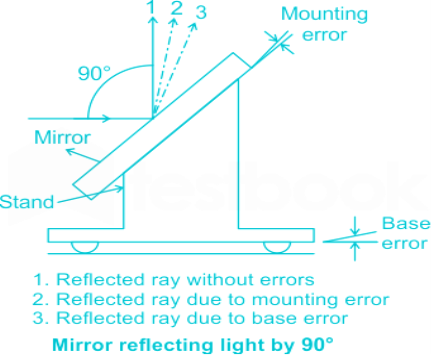
Optical squares are of types.
One kind is outfitted into contraptions like telescopes, in which an optical rectangular is factory-suited for make certain that the road of sight is perpendicular to the vertex.
The 2nd kind comes with the vital attachments for making modifications to the road of sight. This flexibility lets in optical squares for use in some of programs in metrology.
The above schematic diagram illustrates using optical squares to check the suaveness of device sideways.
The suaveness of the vertical slide way with appreciate to a horizontal slide way or mattress is of maximum significance in device tools.
The take a look at setup calls for an autocollimator, aircraft reflectors, and an optical rectangular. It is vital to take handiest readings, one with the reflector at function A and a 2nd at function B, the optical rectangular being set down on the intersection of the 2 surfaces while the analyzing at B is taken.
The distinction among the 2 readings is the suaveness blunders.
Use of the Optical Square
- This is a tool 2 in. Diameter through 3/four in.
- F is a tumbler 1/2 of silvered and 1/2 of plain the junction line being with inside the aircraft of the tool: G is an entire reflect.
- In the usage of the tool for sighting poles as proven, it'd be held with inside the left hand; with the attention at A, the pole D might be visible via the outlet B and the obvious a part of the glass F;
- The observer being on the factor in which a proper attitude might be measured among D H, E H. Rays of mild from pole E will attain reflect G and be contemplated from there to the silvered a part of glass F and thence to the attention at A,
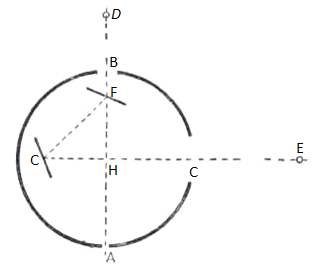
Fig: Optical Square terminologies
- In order that the glass F will appear to be Fig. 2,
- The piece of pole J visible through direct imaginative and prescient being precisely over the piece of pole K visible through reflection.
- If in the usage of the tool the poles do now no longer coincide,
- The station of the observer need to be shifted till they do, or as an opportunity one of the poles need to be shifted.
- If the poles seem to coincide on the junction of the glasses however now no longer to be in a directly line, it'll he because of one of the poles being at a better stage than the other.
Testing of optical square:
Observe the ranging rod at A with optical rectangular stationed at a few intermediate factor C and aligned alongside line AB (Figure (a).
Mark a factor as perpendicular offset at C.
Further, look at the ranging rod at B, despite the fact that closing device stationed at C and aligned alongside AB, and mark the offset factor b.
If the optical rectangular is correctly adjusted then it factors a and b could be coinciding. If this isn't always then, the device calls for adjustment.
The distance abs is bisected at D.
Then CD could be authentic offset. Remain the ranging rod at D. And rotate reflect M2, until photo of A and B, i.e. factor a or b coincides in conjunction with D as depicted in Figure (a).
A technique is repeated until each the observations, via optical rectangular, offer anunmarried offset function D inside region of a and b.
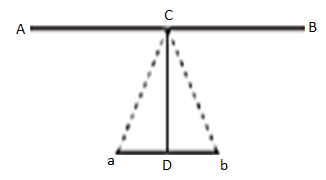
Fig: Testing of optical square
Line Ranger:
Line Ranger is a light-weight tool inclusive of proper-angled isosceles prisms (aircraft mirrors) located one above the opposite and one sight vane such that the surveyor can see the picture shaped at the prism.
The higher prism is movable and may be adjusted even as the decrease prism is fixed.
Diagonals of the prism are silver lined such that they replicate incident ray.
Line Ranger It is an optical tool used for finding a factor on a line and consequently beneficial for ranging.
The diagonals of the prisms are silvered that allows you to replicate the rays. To discover factor C online AB the surveyor holds the tool in hand and stands close to the approximate role of C.
If he isn't precisely online AB, the ranging rods at A and B seem separated as proven
The surveyor movements from side to side at proper angles to the road AB until the snap shots of ranging rods at A and B seem in a unmarried line as proven in
It takes place simplest whilst the optical rectangular is precisely online AB. Thus the favored factor C is placed on the road AB.
Its benefit is it desires simplest one man or woman to range.
The tool need to be every now and then examined via way of means of marking 3 factors in a line and status on center factor gazing the accident of the ranging rods
If the snap shots of the 2 ranging rods do now no longer seem with inside the identical line, one of the prism is adjusted via way of means of working the screw furnished for it.
Key Takeaways:
- Suitability The closed traverse is appropriate for finding the limits of lakes, woods, and many others and for a survey of big areas.
- Angles constant with the aid of using linear or tie measurements are called chain angles.
- In general, Surveying is primarily based totally upon some of principles (or guidelines) which may be indexed as follows:
Compass Traversing:
A compass traverse is a technique of filling in element on a topographic, geologic, or different map. It is a technique of surveying a path along with a stream, path, or the threshold of an outcrop with the aid of a sequence of traverse legs , of every of which the bearing is found through compass and the period measured without delay with inside the field.
It can be defined as a zigzag. The traverse can be closed or open relying on whether or not or now no longer it returns to the beginning point.
A place can be surveyed with the aid of a grid of traverse traces. For many centuries mariners have navigated through a sequence of courses, dictated normally through the wind, the bearing of every route being given through the compass and the period from an estimate of velocity and elapsed time.
The ensuing useless reckoning changed into checked at appropriate periods through astronomical statement or from bearings to acknowledged factors. Many coastlines have been surveyed on this manner, however even though there's no actual report whilst the technique changed into first utilized in land surveying, it seems...
A kind of survey that includes each linear in addition to angular measurements called Compass Traversing.
In Traverse surveying the guidelines of survey traces re constant through angular measurements and now no longer through forming a community of triangles as achieved in chain surveying.
A traverse survey is one wherein framework encompass a sequence of linked traces, the duration and guidelines of which measured with a sequence or tape and angular gadgets respectively.
The habitual of converting and offsetting is similar to in chain surveying. The walking off take a look at traces isn't always necessary.
Types of Traverse
There are commonly types,
Closed Traverse
A traverse stated to close while an entire circuit made i.e. while it returns to the place to begin forming a closed polygon OR while it starts and ends at factors whose positions on plan known.
The paintings might also additionally checked or “balanced”. Suitable for finding bounders of lakes, woods and so on and for the survey of reasonably big area.
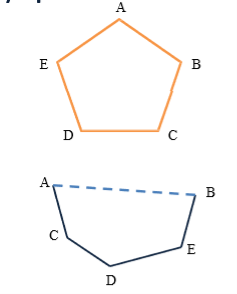
Open Traverse
A traverse stated to open or unclosed while it does now no longer shape a closed polygon. It encompass connecting traces extending with inside the equal well-known route and now no longer returning to the place to begin.
Similarly it does now no longer begin and cease as factors whose positions on plan known. It is appropriate for the survey of lengthy slender strip Egg River, coast line, road, and railway and so on.
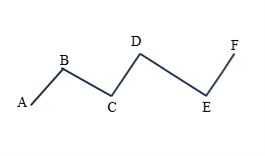
Prismatic and Surveyor's Compass:
Surveyors Compass:
Used with a series while traversing, this device supplied a tremendously brief approach of measuring horizontal guidelines in surveying, however now no longer with the accuracy of a theodolite.
There are essential styles of magnetic compass utilized in surveying, each of that are covered within side the collection - the Surveyor's compass and the Prismatic compass.
The surveyor's compass is typically the bigger and greater correct device, and is typically used on a stand or tripod.
The prismatic compass is usually a small device that is held within side the hand for observing, and is consequently hired for much less correct work.
This surveyor's compass includes a long, thin, pointed needle of magnetized metallic with a small conical-formed bearing of agate cloth on the center.
The stop of this needle which factors north, the north stop, is differentiated from the opposite stop, the south stop, via way of means of a small metallic pin which passes horizontally via the needle close to its north stop.
The agate bearing works on a pointed pivot of tough metallic carried on the center of the low cylindrical metallic container (140mm in diameter).
Attached to the alternative ends of this container are sighting vanes with gradual movement screws and clamps which permit a particular line of sight to be described or laid out.
The device can both be screwed directly to a tripod and continue to be handheld for the reason of measuring magnetic bearings.
The metallic container contains inner it, 3 graduated horizontal circles: pinnacle and decrease circles 0-360 ranges, 1/3 circle in quadrants 0-ninety ranges, with the N and S guidelines diagnosed as 0 factors and the E and W guidelines are labelled as ninety ranges each.
The decrease horizontal circle can examine to three mines immediately at the veneer. The azimuths are typically measured at the pinnacle circle clockwise from north via 360 ranges.

Fig: Surveyors Compass
A disc of glass, becoming on pinnacle of the metallic case, protects the needle and graduated circles. In this device, the needle stays in a set position (the location of the magnetic south to north line), at the same time as the 2 higher graduated circles, collectively with the road of sight, rotate approximately the vertical axis.
While the term 'circus fermenter' changed into constantly used to consult a surveying compass, a general shape of device changed into now no longer set up till the early eighteenth century. Irish and American maker’s produced big numbers of cecum fermenters within side the eighteenth century.
The device changed into greater famous in America than in Britain, and in fact, a whole own circle of relatives of units changed into to increase from the cecum fermenter in America within side the 19th century. There are a few doubts approximately the identification of the inventor of this device however it appears probably too had been Gemma Friseurs within side the first 1/2 of the 16th century.
Prismatic Compass:
A prismatic compass is a navigation and surveying device that's substantially used to discover the bearing of the traversing and blanketed angles among them, waypoints (an endpoint of the course) and direction. Compass surveying is a form of surveying wherein the guidelines of surveying traces are decided with a magnetic compass, and the duration of the surveying traces are measured with a tape or chain or laser variety finder. The compass is commonly used to run a traverse line. The compass calculates bearings of traces with appreciate to magnetic needle. The blanketed angles can then be calculated the usage of appropriate formulation in case of clockwise and anti-clockwise traverse respectively.
The call Prismatic compass is given to it as it basically includes a prism that's used for taking observations greater accurately.
This Prismatic Compass is one of the essential varieties of magnetic compasses covered within side the series for the motive of measuring magnetic bearings, with the alternative being the Surveyor's Compass.
The essential distinction among the 2 units is that the surveyor's compass is generally the bigger and extra correct tool, and is typically used on a stand or tripod.
The prismatic compass however is usually a small tool that is held within side the hand for observing, and is consequently hired at the rougher training of work.
The graduations in this prismatic compass are located on a mild aluminum ring fixed to the needle, and the 0 of the graduations coincides with the south factor of the needle.
The graduations consequently continue to be desk bound with the needle, and the index turns with the sighting vanes. Since the circle is study on the observer's (instead of the targets) cease, the graduations run clockwise from the south cease of the needle while within side the surveyor's compass, the graduations run anti-clockwise from north.
The prism is carried on a mounting which may be moved up and down among slides constant at the out of doors of the case.
The motive of this up-and-down motion is to offer an adjustment for focusing.
The photograph of the graduations is visible through a small round aperture within side the prism mounting, and at once above this aperture is a small V reduce on pinnacle of the mounting, over which the vertical twine within side the front vane can be considered.
When the V reduce, the vertical twine and the station whose bearing is needed are considered in a single line, the bearing is at once study off the graduated arc on the factor at once under the vertical twine.
The rectangular replicate positioned in the front of the ahead vane slides up and down the vane, and is hinged to fold flat over it or to relaxation willing at any perspective with it.
This replicate is used for sun observations, or for viewing any very excessive object, and isn't an everyday becoming to a compass.
The round discs in the front of the again vane are darkish glasses which may be swung in the front of the vane while sun observations are being taken.
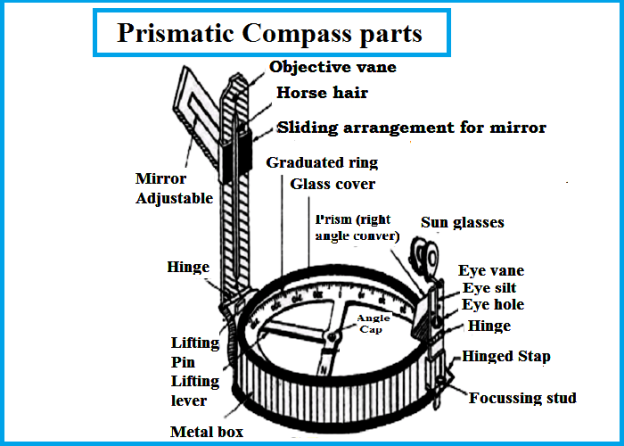
Fig: Prismatic compass
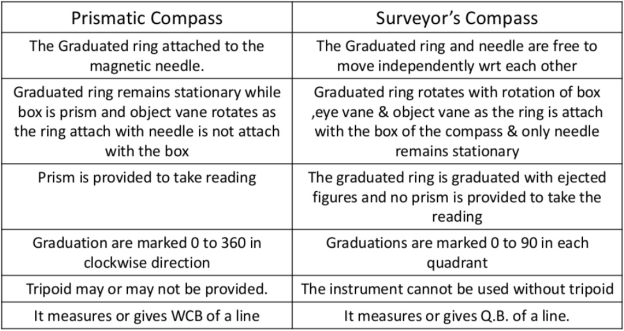
1. True meridian
The line or aircraft passing via the geographical North Pole, geographical South Pole and any point at the floor of the earth, is called the ‘actual meridian’ or ‘geographical meridian’.
The actual meridian at a station is constant. The actual meridians passing via distinct factors at the earth’s floor aren't parallel, however converge toward the poles. But for surveys is small areas, the actual meridians passing via distinct factors are assumed parallel.
The perspective among the actual meridian and a line is called ‘actual bearing’ of the line. It is likewise called the ‘azimuth’.
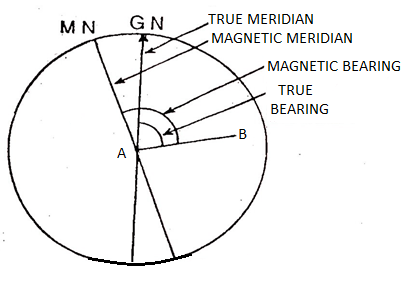
2. Magnetic meridian
When a magnetic needle is suspended freely and balanced properly, unaffected through magnetic substances, it shows a path. This path is called the ‘magnetic meridian’. The perspective among the magnetic meridian and a line is called the ‘magnetic bearing’ or sincerely the ‘bearing’ of the line
Local Attraction:
While compass surveying, the magnetic needle is every so often disturbed from its ordinary function beneath the effect of outside appealing forces. Such a traumatic affect is referred to as neighborhood enchantment. The outside forces are produced through reasserts of neighborhood enchantment which can be contemporary sporting wire (magnetic materials) or metallic gadgets. The time period is likewise used to indicate quantity of deviation of the needle from its ordinary function.
It primarily reasons mistakes in observations whilst surveying and accordingly appropriate strategies are hired to forget about those mistakes Local enchantment is the phenomenon through which the magnetic needle is continuously averted to factor closer to the magnetic north at a place
This is due to the fact that those magnetic compass is encouraged through different magnetic gadgets at that locality together with wires sporting electric powered contemporary, rails, metal and iron structures, metal tapes etc. The prevalence of neighborhood enchantment may be detected through watching the distinction among the fore and again bearings.
If there may be no effect of neighborhood enchantment and different blunders, this distinction may be 180. So we are able to then finish that each stations are loose from neighborhood enchantment.
Elimination of neighborhood enchantment in Compass Surveying Due to neighborhood enchantment extensive quantity of blunders may be arise in compass surveying observations and they may be identical on all of the bearings.
Local enchantment may be minimized the use of following strategies:
Method 1
This technique is primarily based totally at the distinction of fore and again bearings. We already recognize that the distinction among fore and again bearing of a line may be 180˚ if there may be no mistakes in measurement.
So primarily based totally in this blunders loose commentary of bearings, corrections for different strains may be calculated.
However if there may be no bearing has a distinction of 180˚, we are able to calculate the correction from the suggest fee of that bearings which might also additionally have least blunders.
Method 2
This technique is greater quicker technique for making use of correction. This is primarily based totally at the indoors angles of the closed traverse formed.
The indoors angles measured may be accurate on the premise of the reality that those angles aren't suffering from the neighborhood enchantment while the stations are.
So the sum of overall indoors angles for a closed traverse may be (2n-4) 90˚. If there may be any blunders exists each sum will now no longer be identical. The overall blunders may be dispensed the various angles similarly due to the fact identical blunders will arise on every indoors angle. So beginning from the right commentary of bearing which has a distinction in fore and again bearing is 180˚, we are able to calculate all different corrected bearings
Magnetic dip:
- Magnetic dip, dip perspective, or magnetic inclination is the perspective made with the horizontal through the Earth's magnetic subject lines.
- This perspective varies at one of a kind factors at the Earth's surface.
- Positive values of inclination suggest that the magnetic subject of the Earth is pointing downward, into the Earth, on the factor of measurement, and bad values suggest that it's far pointing upward.
- The dip perspective is in precept the perspective made through the needle of a vertically held compass, eleven though in exercise everyday compass needles can be weighted in opposition to dip or can be not able to transport freely in the proper plane.
- The cost may be measured greater reliably with a unique tool generally called a dip circle.
- It is the inclination of magnetic needle of compass with horizontal
- Dip is zero at equator, 90° at poles.
- Dip isn't always constant
- The magnetic dip is described because the perspective made with the horizontal with the aid of using the earth’s magnetic area traces.
- It is likewise called dip perspective or magnetic inclination and become found with the aid of using Georg Hartmann within side the 12 months 1544.
- When the inclination is fantastic it suggests that the earth’s magnetic traces are pointing downward within side the Northern Hemisphere and whilst the inclination is bad it suggests that the earth’s magnetic traces are pointing upward within side the Southern Hemisphere.
- In the 12 months 1581 Robert Norman found a dip circle that is a technique used to degree the dip perspective.
- The different phrases used are isoclinic traces (whilst the contour traces are same on the earth’s surface) and clinic traces (whilst the locus of the factors are having 0 dips).
Inclination:
Magnetic declination is the distinction among the True Meridians and the Magnetic Meridians.
This distinction displays the lean of the earth’s magnetic subject in recognize to its axis of rotation.
Since the magnetic poles and axis of rotation do now no longer precisely coincide, compass needles do now no longer suggest genuine North at maximum web sites within side the northern hemisphere, or genuine south at maximum web sites within side the southern hemisphere.
Most Topographic Maps have a couple of arrows that resemble the arms of a clock within side the decrease left border that suggest the distinction among geographic N and magnetic N for the middle of the place shown.
Aeronautical Charts, to be had at or close to neighborhood airports that provide flight lessons, display a greater whole photo of magnetic declination.
The charts display traces of same magnetic declination referred to as isogonic traces.
Magnetic inclination is the attitude made through a compass needle while the compass is held in a vertical orientation.
Positive values of inclination suggest that the sphere is pointing downward, into the Earth, on the factor of measurement.
Compass traversing adjustment of traverse:
Quadrilateral Traverse Adjustments
A traverse is a survey wherein you have were given occupied each station and measured each mind-set and distance amongst points. An example of a sturdy shape often used for reading deformation, which incorporates on a landslide (Baum and others, 1988
This is wherein all the angles and distances in a quadrilateral are measured over and over and averaged for accuracy. The quadrilateral is then measured at some later date and strain calculated from the extrude in shape of the quadrilateral.
The sum of the interior angles for a quadrilateral must be 360°. Any deviation from that is a diploma of errors. Also, the triangles that make up the quadrilateral must all obey the criminal suggestions of sins and cosines - any deviation is a diploma of errors. Needless to say, each the space measurements or the angles is probably in errors. We moreover have an over-determined system. For example measuring angles and one aspect of a triangle is sufficient to collect the complete triangle (despite the fact that there may be no errors control).
Probably the great method for solving over-determined systems is the strategies of least-squares.
Least Squares Adjustment
An outline of the method of preferred least squares is given within side the subsequent PDF format document (from the G423/523 Course Web pages).
Since we recognize that the quadrilateral must have no errors, and we have got were given glad ourselves that there may be no obvious terrible data in our data set, we can alter the angles and distances just so out shape meets all the geometric criteria.
The most entire adjustment strategies uses least-squares to alter angles and distances so that you make the smallest possible changes
One method for adjusting quadrilaterals is given with the resource of the usage of Smith & Vanes (1987).
Copies of FORTRAN packages from Smith & Vanes are available here: Triangle or Quadrilateral. Note that the packages require ISML routines. An Excel workbook is also available for making the ones changes to a quadrilateral.
Coordinate Adjustment
Simpler techniques of converting traverses are established in plenty of Geology place strategies texts.
A sense of errors in a traverse can be acquired with the resource of the usage of calculating coordinates for each component following the direction of your traverse.
After completing the traverse you need to move returned to the start coordinates, any difference is a diploma of your preferred errors. For a quadrilateral you may perform the following calculations:
From the SE corner, use the mind-set amongst strains from the SE to SW corner and SE to NE corner to calculate the coordinates of the NE corner.
From the NE corner, use the mind-set amongst strains from the NE to SE corner and NE to NW corner to calculate the coordinates of the NE corner.
From the NW corner, use the mind-set amongst strains from the NW to NE corner and NW to SW corner to calculate the coordinates of the SE corner. The difference amongst this calculated coordinate and (0, 0, 0) is your errors of closure.
This closure errors can then be adjusted to zero the usage of each the compass rule or the transit rule. An Excel workbook showing the ones correction strategies is available here.
Compass Rule
In this method the coordinate error is distributed in proportion to the length of traverse lines. The assumption is that the greatest error will come from the longest shots.
- Northing adjustment = Length of traverse line to point / Total length of traverse × Northing closure error
- Easting adjustment = Length of traverse line to point / Total length of traverse × Easting closure error
- Elevation adjustment = Length of traverse line to point / Total length of traverse × Elevation closure error
Transit Rule
In this method, the coordinate error is distributed in proportion to the amount that various coordinates change between points.
- Northing adjustment = Change in Northing for traverse line to point / Sum of absolute values of all changes in northing for all traverse lines × Northing closure error
- Easting adjustment = Change in Northing for traverse line to point / Sum of absolute values of all changes in northing for all traverse lines × Easting closure error
Key Takeaways:
- A kind of survey that includes each linear in addition to angular measurements called Compass Traversing.
- The prismatic compass is usually a small device that is held within side the hand for observing, and is consequently hired for much less correct work.
- The line or aircraft passing via the geographical North Pole, geographical South Pole and any point at the floor of the earth, is called the ‘actual meridian’ or ‘geographical meridian’.
References:
1. Surveying and Levelling by Kanetkar and Kulkarni (Vol.I) Pune Vidhatigrihan Prakashan
2. Surveying and Levelling by Dr. B.C. Punmia (Vol. I & II) Laxmi Pub.
3. Advance Surveying - Total Station, GIS and Remote Sensing by Pearson Education Satheesh Gopi & R. Sathikumar& N. Madhu
Unit - 1
Chain and Compass Traversing
A traverse is a chain of linked traces whose lengths and guidelines are to be measured and the system of surveying to locate such measurements is called traversing.
In general, chains are used to degree period and compass or theodolite are used to degree the course of traverse traces.
The sorts of traverse and strategies of traversing are mentioned on this article.
Traversing is that sort of survey wherein some of linked survey traces shape the framework and the guidelines and lengths of the survey traces are measured with the assist of an attitude measuring tool and tape or chain respectively.
Classification:
There are kinds of traverse surveying.
They are:
Closed traverse:
When the traces shape a circuit which results up on the beginning point, it's far called a closed traverse.
Open traverse:
When the traces shape a circuit ends some other place besides beginning point, it's far stated to be an open traverse.
Suitability The closed traverse is appropriate for finding the limits of lakes, woods, and many others and for a survey of big areas.
The open traverse is appropriate for surveying an extended slender strip of land as required for an avenue of the canal or the coastline. Methods of Traversing There are numerous techniques of traversing, relying at the contraptions utilized in figuring out the relative guidelines of the traverse traces.
The following are the most important techniques:
Chain traversing Chain and compass traversing
Transit kind traversing
a) By speedy needle approach
b) By size of angles among the traces
Plane desk traversing
Brief descriptions of those traverse surveying techniques are given below.
Chain Traversing
The approach wherein the entire paintings is carried out with chain and tape is referred to as chain traversing.
No attitude size is used and the guidelines of the traces are constant totally with the aid of using linear measurements
Angles constant with the aid of using linear or tie measurements are called chain angles.
The approach is mistaken for correct paintings and is commonly used if an attitude measuring contraptions which include a compass, sextant or theodolite is available.
Chain and Compass
Traversing In chain and compass traversing, the magnetic bearings of the survey traces are measured with the aid of using a compass and the lengths of the traces are measured both with a sequence and with a tape.
The path of the magnetic meridian is set up at every traverse station independently. The approach is likewise called a tree or free needle approach.
Traversing with the aid of using Fast Needle Method
The approach wherein the magnetic bearings of traverse traces are measured with the aid of using a theodolite equipped with s compass is referred to as traversing with the aid of using speedy needle approach.
The path of the magnetic meridian isn't set up at every station however instead, the magnetic bearings of the traces are measured with a reference in order that path of the magnetic meridian set up at the primary station.
There are 3 techniques of watching the bearings of traces with the aid of using speedy needle approach.
Direct approach with transiting, direct approach without transiting, Back bearing approach.
Traversing By Direct Observation Of Angles
In this approach, the angles among the traces are immediately measured with the aid of using a theodolite and the magnetic bearing of different traces may be calculated on this approach.
The angles measured at exceptional stations can be both
Included Angles and Deflection Angles
Traversing with the aid of using Included Angle
A covered attitude at a station is both of the 2 angles shaped by survey traces assembly there and those angles must be measured clockwise.
The approach is composed absolutely in measuring every attitude immediately from an again sight at the previous station.
The angled will also be measured with the aid of using repetition. The angles measured from the again station can be indoors or outside relying at the path of development.
Traversing by included angle
In Fig (a) the path of development is counter-clockwise and so the angles measured clockwise are the indoors attitude. In Fig (a) the path of development is clockwise and so the angles measured clockwise are the outside attitude.
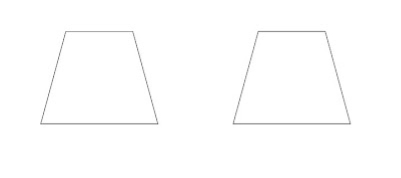
Traverse with the aid of using Deflection Angles
A deflection attitude is an attitude wherein a survey line makes with the prolongation of the previous line. It is particular as right (R) or left (L) as it's far measured clockwise or anti-clockwise from the prolongation of the preceding line. This sort of traversing is extra appropriate for the survey of roads, railways, pipe-traces, and many others wherein the survey traces make small deflection angles.
Principles of survey:
Surveying is largely carried out for measuring the linear parameters in addition to the angular parameters for the established order of factors by using which the plans and maps may be prepared. It makes use of an extensive type of equipment and system.
Some of the critical system utilized in surveying consists of theodolite, compass, auto-stage, chains, and tapes, leveling staff, and many others. Surveying is the maximum critical department of civil engineering earlier than and after all of the civil engineering works consisting of designing and creation of roads, buildings, bridges, irrigation, and water delivery systems, and many others. It essentially gives the primary framework for the conception, design, and execution of the development works. The manner of surveying consists of each fieldwork and workplace paintings.
In general, Surveying is primarily based totally upon some of principles (or guidelines) which may be indexed as follows:
a. Working from Whole to Part
b. Location of Point with the aid of using Measurement from Two Points of Reference
c. Consistency of Work
d. Independent Check
e. Accuracy Required
a. Working from Whole to Part
As the call itself implies, the survey paintings need to be finished from entire to component. This method that after a place is to be surveyed, first of all, a device of manipulate factors is installed such that it covers the whole region with a better diploma of precision.
After this, the minor manipulate factors and information are similarly installed with a lesser diploma of precision.
The principal concept of this precept is to save you the undue accumulation of mistakes and thereby manipulate and localize the minor mistakes. If the survey is finished from component to entire, the magnitudes of mistakes gathered could be very high.
Example: This precept is crucial in International Boundary Locating, Property Boundary Locating, and many others.
b. Location of Point with the aid of using Measurement
From Two Points of Reference
On the idea of this precept, the relative function of the favored factors to be surveyed need to be placed with the aid of using taking the dimension from at the least two (ideally three) factors of reference, such that the placement of the reference factors have already been constant previously.
c. Consistency of Work
Another critical precept of surveying is the consistency of paintings. It need to be cited that preserving consistency with inside the technique, device, studying and noting observations, and many others enables to benefit the favored stage of accuracy.
d. Independent Check
Independent take a look at is the essential precept this is normally followed to save you blunders with inside the survey paintings. According to this precept, each dimension this is taken with inside the area need to be re-checked with the aid of using adopting an appropriate technique of unbiased area assessments and observations in order that any mistake if gift isn't surpassed without notice.
e. Accuracy
Required According to this precept of surveying; the right technique and device need to be used for the survey paintings on the idea of the diploma of accuracy required.
Tape survey:
Today, measuring tapes made for sewing are crafted from fiberglass, which does now not tear or stretch as without issues.
Measuring tapes designed for carpentry or introduction often use a stiff, curved metallic ribbon that may live stiff and without delay at the same time as extended, but retracts proper right into a coil for accessible storage.
This type of tape diploma should have a floating tang or hook on the forestall to beneficial aid measuring.
The tang is established to the tape with unfastened rivets through oval holes, and might by skip a distance identical to its thickness, to provide every inside and outside measurements which may be accurate.
A tape diploma of 25 or perhaps a hundred feet can wind proper right into a fantastically small container. The self-marking tape diploma allows the individual an accurate one hand diploma.
A tape diploma or measuring tape is a flexible ruler used to diploma period or distance. It consists of a ribbon of fabric, plastic, fiber glass, or metal strip with linear length markings.
It is a now no longer unusual place measuring tool. Its format allows for a diploma of first-rate length to be without issues carried in pocket or toolkit and lets in one to diploma spherical curves or corners.
TAPING:
Taping is the linear size of the horizontal distance among factors the usage of a surveyor's tape. Observation of horizontal distances through taping is composed of. Making use of the recognized duration of a graduated tape at once to line a. Range of times.
Invar, an alloy of nickel and metal having a totally low coefficient of enlargement, resolved the thermal enlargement trouble related to the usage of different steel rods and tapes for distance size.
With the discovery of invar, tapes and wires have become possible for measuring distances.
Keeping this in consideration, what are the kinds of tapes in surveying? There are five kinds of tapes to be had in surveying for linear measurements and they're as follows:
- Linen Tape.
- Woven Metallic Tape.
- Steel Tape.
- Linen Tape.
What is the reason of taping?
Athletic taping is the procedure of making use of tape at once to the pores and skin which will preserve a strong role of bones and muscular tissues throughout athletic activity.
Taping is typically used to assist get over overuse and different injuries.
Cross Staff Survey:
The cross-workforce is a device used to degree angles and altitudes, which include a trigonometrically graduated workforce and one or greater perpendicular vanes shifting over it.
First defined in approximately 1342 through the Jewish logician and scientist Levi ben Garson and firstly used for astronomical and surveying purposes, it have become a mariner's navigational device with inside the sixteenth century (additionally recognized as 'ballast Ella', 'Jacob's workforce ' or 'fore-workforce').
The device became especially used for locating the range through measuring the altitude of the polar big name and for measuring the altitude of the solar. In the latter use, the observer needed to face the solar and this inconvenience brought about the improvement of the back-workforce.
To degree the altitude of a celestial body, the eye-quit of the workforce became positioned close to the observer's eye and the opposite quit 1/2 of manner among the horizon and the celestial body.
The altitude should then be examine off the workforce.
This form of survey is undertaken to discover barriers of a subject or a subject or plat and determinations of its location.
Principle:
The precept of the survey is to divide the given location in to no of proper angled triangles and trapezoids and to calculate and plot the regions of triangles and trapezoids.
Instruments/Material Required:
Two Chains, arrows taps, ranging rods, move-body of workers and drawing material
Two chains are normally supplied one for measuring distance alongside the chain line and different for measuring the offsets.
The move body of workers is used to set out the perpendicular instructions for offsets. In this survey, the bottom line runs via the middle of the location, in order that the offsets are left or proper aspect of final analysis are pretty same.
To test accuracy duration of the boundary strains will also be measured. After the sector paintings is over, the survey is plotted to an appropriate scale.
Calculations of Field Area:
By this approach of survey, the sector as divided in to proper angled triangles and trapezoids are calculated as under:
- Area of proper -angled triangle = ½ base x Height.
- Area of trapezoid= sum of parallel sides/2 x Height.
Add the regions of all of the triangles & trapezoids and sum is same to the entire of a subject.
Construction, use and testing of optical square:
The optical rectangular makes use of a pent prism to mirror and refract a beam or sighting ninety degrees, it's far utilized in pairs in surveying and in a novel block in metrology.
In optical rectangular A Horizon glass is located at a perspective of 120° with the horizon sight.
The Index glass is located at a perspective of 105° with the Index sight. Angle among Index glass and Horizon glass is 45°.
An optical rectangular is beneficial in turning the road of sight through ninety° from its unique course.
Many optical contraptions, in particular microscopes, have this requirement. An Optical rectangular is are basically a pentagonal prism (pent prism).
Regardless of the perspective at which the incident beam moves the face of the prism, it's far grew to become through ninety° through inner reflection. Unlike a flat reflect, the accuracy of a pent prism will now no longer be stricken by the mistakes gift with inside the mounting arrangement.
From the above schematic diagram, a reflect is stored at an perspective of 45° with appreciate to the incident ray of mild in order that the pondered ray may be at an perspective of ninety° with appreciate to the incident ray.
These mistakes in aggregate might also additionally also be more than the work piece suaveness blunders.
This hassle can be conquer through the use of an optical rectangular. The above schematic diagram illustrates the optical course through an optical rectangular.
The incident ray is pondered internally from faces and emerges from the rectangular at precisely ninety° to the incident mild.
This is a first rate property. Any moderate deviation or misalignment of the prism does now no longer have an effect on the proper perspective motion of the mild ray.
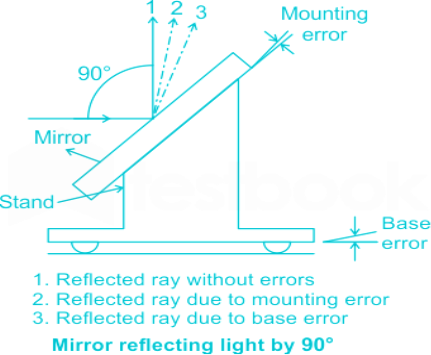
Optical squares are of types.
One kind is outfitted into contraptions like telescopes, in which an optical rectangular is factory-suited for make certain that the road of sight is perpendicular to the vertex.
The 2nd kind comes with the vital attachments for making modifications to the road of sight. This flexibility lets in optical squares for use in some of programs in metrology.
The above schematic diagram illustrates using optical squares to check the suaveness of device sideways.
The suaveness of the vertical slide way with appreciate to a horizontal slide way or mattress is of maximum significance in device tools.
The take a look at setup calls for an autocollimator, aircraft reflectors, and an optical rectangular. It is vital to take handiest readings, one with the reflector at function A and a 2nd at function B, the optical rectangular being set down on the intersection of the 2 surfaces while the analyzing at B is taken.
The distinction among the 2 readings is the suaveness blunders.
Use of the Optical Square
- This is a tool 2 in. Diameter through 3/four in.
- F is a tumbler 1/2 of silvered and 1/2 of plain the junction line being with inside the aircraft of the tool: G is an entire reflect.
- In the usage of the tool for sighting poles as proven, it'd be held with inside the left hand; with the attention at A, the pole D might be visible via the outlet B and the obvious a part of the glass F;
- The observer being on the factor in which a proper attitude might be measured among D H, E H. Rays of mild from pole E will attain reflect G and be contemplated from there to the silvered a part of glass F and thence to the attention at A,
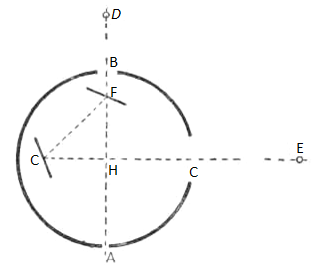
Fig: Optical Square terminologies
- In order that the glass F will appear to be Fig. 2,
- The piece of pole J visible through direct imaginative and prescient being precisely over the piece of pole K visible through reflection.
- If in the usage of the tool the poles do now no longer coincide,
- The station of the observer need to be shifted till they do, or as an opportunity one of the poles need to be shifted.
- If the poles seem to coincide on the junction of the glasses however now no longer to be in a directly line, it'll he because of one of the poles being at a better stage than the other.
Testing of optical square:
Observe the ranging rod at A with optical rectangular stationed at a few intermediate factor C and aligned alongside line AB (Figure (a).
Mark a factor as perpendicular offset at C.
Further, look at the ranging rod at B, despite the fact that closing device stationed at C and aligned alongside AB, and mark the offset factor b.
If the optical rectangular is correctly adjusted then it factors a and b could be coinciding. If this isn't always then, the device calls for adjustment.
The distance abs is bisected at D.
Then CD could be authentic offset. Remain the ranging rod at D. And rotate reflect M2, until photo of A and B, i.e. factor a or b coincides in conjunction with D as depicted in Figure (a).
A technique is repeated until each the observations, via optical rectangular, offer anunmarried offset function D inside region of a and b.
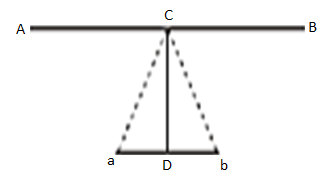
Fig: Testing of optical square
Line Ranger:
Line Ranger is a light-weight tool inclusive of proper-angled isosceles prisms (aircraft mirrors) located one above the opposite and one sight vane such that the surveyor can see the picture shaped at the prism.
The higher prism is movable and may be adjusted even as the decrease prism is fixed.
Diagonals of the prism are silver lined such that they replicate incident ray.
Line Ranger It is an optical tool used for finding a factor on a line and consequently beneficial for ranging.
The diagonals of the prisms are silvered that allows you to replicate the rays. To discover factor C online AB the surveyor holds the tool in hand and stands close to the approximate role of C.
If he isn't precisely online AB, the ranging rods at A and B seem separated as proven
The surveyor movements from side to side at proper angles to the road AB until the snap shots of ranging rods at A and B seem in a unmarried line as proven in
It takes place simplest whilst the optical rectangular is precisely online AB. Thus the favored factor C is placed on the road AB.
Its benefit is it desires simplest one man or woman to range.
The tool need to be every now and then examined via way of means of marking 3 factors in a line and status on center factor gazing the accident of the ranging rods
If the snap shots of the 2 ranging rods do now no longer seem with inside the identical line, one of the prism is adjusted via way of means of working the screw furnished for it.
Key Takeaways:
- Suitability The closed traverse is appropriate for finding the limits of lakes, woods, and many others and for a survey of big areas.
- Angles constant with the aid of using linear or tie measurements are called chain angles.
- In general, Surveying is primarily based totally upon some of principles (or guidelines) which may be indexed as follows:
Compass Traversing:
A compass traverse is a technique of filling in element on a topographic, geologic, or different map. It is a technique of surveying a path along with a stream, path, or the threshold of an outcrop with the aid of a sequence of traverse legs , of every of which the bearing is found through compass and the period measured without delay with inside the field.
It can be defined as a zigzag. The traverse can be closed or open relying on whether or not or now no longer it returns to the beginning point.
A place can be surveyed with the aid of a grid of traverse traces. For many centuries mariners have navigated through a sequence of courses, dictated normally through the wind, the bearing of every route being given through the compass and the period from an estimate of velocity and elapsed time.
The ensuing useless reckoning changed into checked at appropriate periods through astronomical statement or from bearings to acknowledged factors. Many coastlines have been surveyed on this manner, however even though there's no actual report whilst the technique changed into first utilized in land surveying, it seems...
A kind of survey that includes each linear in addition to angular measurements called Compass Traversing.
In Traverse surveying the guidelines of survey traces re constant through angular measurements and now no longer through forming a community of triangles as achieved in chain surveying.
A traverse survey is one wherein framework encompass a sequence of linked traces, the duration and guidelines of which measured with a sequence or tape and angular gadgets respectively.
The habitual of converting and offsetting is similar to in chain surveying. The walking off take a look at traces isn't always necessary.
Types of Traverse
There are commonly types,
Closed Traverse
A traverse stated to close while an entire circuit made i.e. while it returns to the place to begin forming a closed polygon OR while it starts and ends at factors whose positions on plan known.
The paintings might also additionally checked or “balanced”. Suitable for finding bounders of lakes, woods and so on and for the survey of reasonably big area.
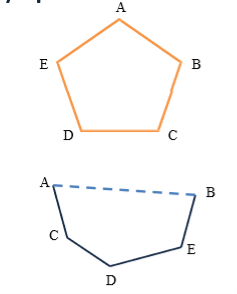
Open Traverse
A traverse stated to open or unclosed while it does now no longer shape a closed polygon. It encompass connecting traces extending with inside the equal well-known route and now no longer returning to the place to begin.
Similarly it does now no longer begin and cease as factors whose positions on plan known. It is appropriate for the survey of lengthy slender strip Egg River, coast line, road, and railway and so on.
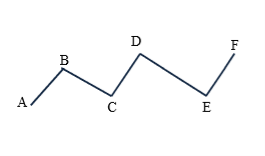
Prismatic and Surveyor's Compass:
Surveyors Compass:
Used with a series while traversing, this device supplied a tremendously brief approach of measuring horizontal guidelines in surveying, however now no longer with the accuracy of a theodolite.
There are essential styles of magnetic compass utilized in surveying, each of that are covered within side the collection - the Surveyor's compass and the Prismatic compass.
The surveyor's compass is typically the bigger and greater correct device, and is typically used on a stand or tripod.
The prismatic compass is usually a small device that is held within side the hand for observing, and is consequently hired for much less correct work.
This surveyor's compass includes a long, thin, pointed needle of magnetized metallic with a small conical-formed bearing of agate cloth on the center.
The stop of this needle which factors north, the north stop, is differentiated from the opposite stop, the south stop, via way of means of a small metallic pin which passes horizontally via the needle close to its north stop.
The agate bearing works on a pointed pivot of tough metallic carried on the center of the low cylindrical metallic container (140mm in diameter).
Attached to the alternative ends of this container are sighting vanes with gradual movement screws and clamps which permit a particular line of sight to be described or laid out.
The device can both be screwed directly to a tripod and continue to be handheld for the reason of measuring magnetic bearings.
The metallic container contains inner it, 3 graduated horizontal circles: pinnacle and decrease circles 0-360 ranges, 1/3 circle in quadrants 0-ninety ranges, with the N and S guidelines diagnosed as 0 factors and the E and W guidelines are labelled as ninety ranges each.
The decrease horizontal circle can examine to three mines immediately at the veneer. The azimuths are typically measured at the pinnacle circle clockwise from north via 360 ranges.
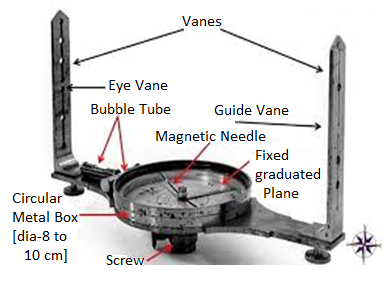
Fig: Surveyors Compass
A disc of glass, becoming on pinnacle of the metallic case, protects the needle and graduated circles. In this device, the needle stays in a set position (the location of the magnetic south to north line), at the same time as the 2 higher graduated circles, collectively with the road of sight, rotate approximately the vertical axis.
While the term 'circus fermenter' changed into constantly used to consult a surveying compass, a general shape of device changed into now no longer set up till the early eighteenth century. Irish and American maker’s produced big numbers of cecum fermenters within side the eighteenth century.
The device changed into greater famous in America than in Britain, and in fact, a whole own circle of relatives of units changed into to increase from the cecum fermenter in America within side the 19th century. There are a few doubts approximately the identification of the inventor of this device however it appears probably too had been Gemma Friseurs within side the first 1/2 of the 16th century.
Prismatic Compass:
A prismatic compass is a navigation and surveying device that's substantially used to discover the bearing of the traversing and blanketed angles among them, waypoints (an endpoint of the course) and direction. Compass surveying is a form of surveying wherein the guidelines of surveying traces are decided with a magnetic compass, and the duration of the surveying traces are measured with a tape or chain or laser variety finder. The compass is commonly used to run a traverse line. The compass calculates bearings of traces with appreciate to magnetic needle. The blanketed angles can then be calculated the usage of appropriate formulation in case of clockwise and anti-clockwise traverse respectively.
The call Prismatic compass is given to it as it basically includes a prism that's used for taking observations greater accurately.
This Prismatic Compass is one of the essential varieties of magnetic compasses covered within side the series for the motive of measuring magnetic bearings, with the alternative being the Surveyor's Compass.
The essential distinction among the 2 units is that the surveyor's compass is generally the bigger and extra correct tool, and is typically used on a stand or tripod.
The prismatic compass however is usually a small tool that is held within side the hand for observing, and is consequently hired at the rougher training of work.
The graduations in this prismatic compass are located on a mild aluminum ring fixed to the needle, and the 0 of the graduations coincides with the south factor of the needle.
The graduations consequently continue to be desk bound with the needle, and the index turns with the sighting vanes. Since the circle is study on the observer's (instead of the targets) cease, the graduations run clockwise from the south cease of the needle while within side the surveyor's compass, the graduations run anti-clockwise from north.
The prism is carried on a mounting which may be moved up and down among slides constant at the out of doors of the case.
The motive of this up-and-down motion is to offer an adjustment for focusing.
The photograph of the graduations is visible through a small round aperture within side the prism mounting, and at once above this aperture is a small V reduce on pinnacle of the mounting, over which the vertical twine within side the front vane can be considered.
When the V reduce, the vertical twine and the station whose bearing is needed are considered in a single line, the bearing is at once study off the graduated arc on the factor at once under the vertical twine.
The rectangular replicate positioned in the front of the ahead vane slides up and down the vane, and is hinged to fold flat over it or to relaxation willing at any perspective with it.
This replicate is used for sun observations, or for viewing any very excessive object, and isn't an everyday becoming to a compass.
The round discs in the front of the again vane are darkish glasses which may be swung in the front of the vane while sun observations are being taken.
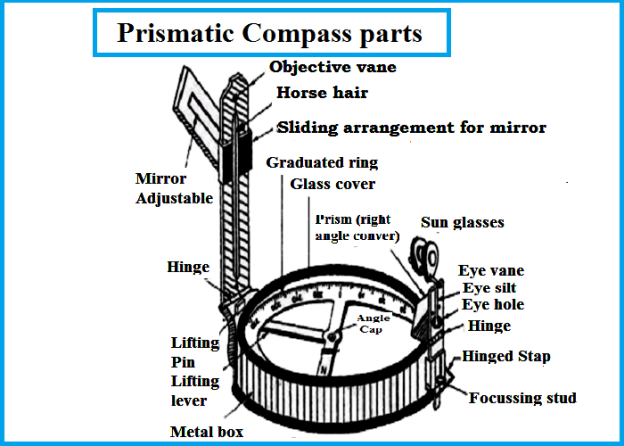
Fig: Prismatic compass
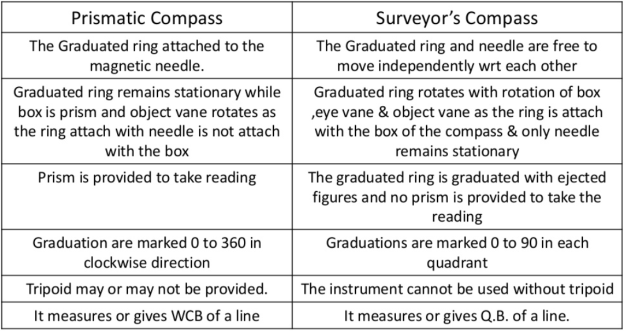
1. True meridian
The line or aircraft passing via the geographical North Pole, geographical South Pole and any point at the floor of the earth, is called the ‘actual meridian’ or ‘geographical meridian’.
The actual meridian at a station is constant. The actual meridians passing via distinct factors at the earth’s floor aren't parallel, however converge toward the poles. But for surveys is small areas, the actual meridians passing via distinct factors are assumed parallel.
The perspective among the actual meridian and a line is called ‘actual bearing’ of the line. It is likewise called the ‘azimuth’.
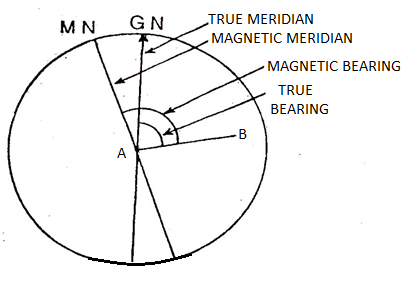
2. Magnetic meridian
When a magnetic needle is suspended freely and balanced properly, unaffected through magnetic substances, it shows a path. This path is called the ‘magnetic meridian’. The perspective among the magnetic meridian and a line is called the ‘magnetic bearing’ or sincerely the ‘bearing’ of the line
Local Attraction:
While compass surveying, the magnetic needle is every so often disturbed from its ordinary function beneath the effect of outside appealing forces. Such a traumatic affect is referred to as neighborhood enchantment. The outside forces are produced through reasserts of neighborhood enchantment which can be contemporary sporting wire (magnetic materials) or metallic gadgets. The time period is likewise used to indicate quantity of deviation of the needle from its ordinary function.
It primarily reasons mistakes in observations whilst surveying and accordingly appropriate strategies are hired to forget about those mistakes Local enchantment is the phenomenon through which the magnetic needle is continuously averted to factor closer to the magnetic north at a place
This is due to the fact that those magnetic compass is encouraged through different magnetic gadgets at that locality together with wires sporting electric powered contemporary, rails, metal and iron structures, metal tapes etc. The prevalence of neighborhood enchantment may be detected through watching the distinction among the fore and again bearings.
If there may be no effect of neighborhood enchantment and different blunders, this distinction may be 180. So we are able to then finish that each stations are loose from neighborhood enchantment.
Elimination of neighborhood enchantment in Compass Surveying Due to neighborhood enchantment extensive quantity of blunders may be arise in compass surveying observations and they may be identical on all of the bearings.
Local enchantment may be minimized the use of following strategies:
Method 1
This technique is primarily based totally at the distinction of fore and again bearings. We already recognize that the distinction among fore and again bearing of a line may be 180˚ if there may be no mistakes in measurement.
So primarily based totally in this blunders loose commentary of bearings, corrections for different strains may be calculated.
However if there may be no bearing has a distinction of 180˚, we are able to calculate the correction from the suggest fee of that bearings which might also additionally have least blunders.
Method 2
This technique is greater quicker technique for making use of correction. This is primarily based totally at the indoors angles of the closed traverse formed.
The indoors angles measured may be accurate on the premise of the reality that those angles aren't suffering from the neighborhood enchantment while the stations are.
So the sum of overall indoors angles for a closed traverse may be (2n-4) 90˚. If there may be any blunders exists each sum will now no longer be identical. The overall blunders may be dispensed the various angles similarly due to the fact identical blunders will arise on every indoors angle. So beginning from the right commentary of bearing which has a distinction in fore and again bearing is 180˚, we are able to calculate all different corrected bearings
Magnetic dip:
- Magnetic dip, dip perspective, or magnetic inclination is the perspective made with the horizontal through the Earth's magnetic subject lines.
- This perspective varies at one of a kind factors at the Earth's surface.
- Positive values of inclination suggest that the magnetic subject of the Earth is pointing downward, into the Earth, on the factor of measurement, and bad values suggest that it's far pointing upward.
- The dip perspective is in precept the perspective made through the needle of a vertically held compass, eleven though in exercise everyday compass needles can be weighted in opposition to dip or can be not able to transport freely in the proper plane.
- The cost may be measured greater reliably with a unique tool generally called a dip circle.
- It is the inclination of magnetic needle of compass with horizontal
- Dip is zero at equator, 90° at poles.
- Dip isn't always constant
- The magnetic dip is described because the perspective made with the horizontal with the aid of using the earth’s magnetic area traces.
- It is likewise called dip perspective or magnetic inclination and become found with the aid of using Georg Hartmann within side the 12 months 1544.
- When the inclination is fantastic it suggests that the earth’s magnetic traces are pointing downward within side the Northern Hemisphere and whilst the inclination is bad it suggests that the earth’s magnetic traces are pointing upward within side the Southern Hemisphere.
- In the 12 months 1581 Robert Norman found a dip circle that is a technique used to degree the dip perspective.
- The different phrases used are isoclinic traces (whilst the contour traces are same on the earth’s surface) and clinic traces (whilst the locus of the factors are having 0 dips).
Inclination:
Magnetic declination is the distinction among the True Meridians and the Magnetic Meridians.
This distinction displays the lean of the earth’s magnetic subject in recognize to its axis of rotation.
Since the magnetic poles and axis of rotation do now no longer precisely coincide, compass needles do now no longer suggest genuine North at maximum web sites within side the northern hemisphere, or genuine south at maximum web sites within side the southern hemisphere.
Most Topographic Maps have a couple of arrows that resemble the arms of a clock within side the decrease left border that suggest the distinction among geographic N and magnetic N for the middle of the place shown.
Aeronautical Charts, to be had at or close to neighborhood airports that provide flight lessons, display a greater whole photo of magnetic declination.
The charts display traces of same magnetic declination referred to as isogonic traces.
Magnetic inclination is the attitude made through a compass needle while the compass is held in a vertical orientation.
Positive values of inclination suggest that the sphere is pointing downward, into the Earth, on the factor of measurement.
Compass traversing adjustment of traverse:
Quadrilateral Traverse Adjustments
A traverse is a survey wherein you have were given occupied each station and measured each mind-set and distance amongst points. An example of a sturdy shape often used for reading deformation, which incorporates on a landslide (Baum and others, 1988
This is wherein all the angles and distances in a quadrilateral are measured over and over and averaged for accuracy. The quadrilateral is then measured at some later date and strain calculated from the extrude in shape of the quadrilateral.
The sum of the interior angles for a quadrilateral must be 360°. Any deviation from that is a diploma of errors. Also, the triangles that make up the quadrilateral must all obey the criminal suggestions of sins and cosines - any deviation is a diploma of errors. Needless to say, each the space measurements or the angles is probably in errors. We moreover have an over-determined system. For example measuring angles and one aspect of a triangle is sufficient to collect the complete triangle (despite the fact that there may be no errors control).
Probably the great method for solving over-determined systems is the strategies of least-squares.
Least Squares Adjustment
An outline of the method of preferred least squares is given within side the subsequent PDF format document (from the G423/523 Course Web pages).
Since we recognize that the quadrilateral must have no errors, and we have got were given glad ourselves that there may be no obvious terrible data in our data set, we can alter the angles and distances just so out shape meets all the geometric criteria.
The most entire adjustment strategies uses least-squares to alter angles and distances so that you make the smallest possible changes
One method for adjusting quadrilaterals is given with the resource of the usage of Smith & Vanes (1987).
Copies of FORTRAN packages from Smith & Vanes are available here: Triangle or Quadrilateral. Note that the packages require ISML routines. An Excel workbook is also available for making the ones changes to a quadrilateral.
Coordinate Adjustment
Simpler techniques of converting traverses are established in plenty of Geology place strategies texts.
A sense of errors in a traverse can be acquired with the resource of the usage of calculating coordinates for each component following the direction of your traverse.
After completing the traverse you need to move returned to the start coordinates, any difference is a diploma of your preferred errors. For a quadrilateral you may perform the following calculations:
From the SE corner, use the mind-set amongst strains from the SE to SW corner and SE to NE corner to calculate the coordinates of the NE corner.
From the NE corner, use the mind-set amongst strains from the NE to SE corner and NE to NW corner to calculate the coordinates of the NE corner.
From the NW corner, use the mind-set amongst strains from the NW to NE corner and NW to SW corner to calculate the coordinates of the SE corner. The difference amongst this calculated coordinate and (0, 0, 0) is your errors of closure.
This closure errors can then be adjusted to zero the usage of each the compass rule or the transit rule. An Excel workbook showing the ones correction strategies is available here.
Compass Rule
In this method the coordinate error is distributed in proportion to the length of traverse lines. The assumption is that the greatest error will come from the longest shots.
- Northing adjustment = Length of traverse line to point / Total length of traverse × Northing closure error
- Easting adjustment = Length of traverse line to point / Total length of traverse × Easting closure error
- Elevation adjustment = Length of traverse line to point / Total length of traverse × Elevation closure error
Transit Rule
In this method, the coordinate error is distributed in proportion to the amount that various coordinates change between points.
- Northing adjustment = Change in Northing for traverse line to point / Sum of absolute values of all changes in northing for all traverse lines × Northing closure error
- Easting adjustment = Change in Northing for traverse line to point / Sum of absolute values of all changes in northing for all traverse lines × Easting closure error
Key Takeaways:
- A kind of survey that includes each linear in addition to angular measurements called Compass Traversing.
- The prismatic compass is usually a small device that is held within side the hand for observing, and is consequently hired for much less correct work.
- The line or aircraft passing via the geographical North Pole, geographical South Pole and any point at the floor of the earth, is called the ‘actual meridian’ or ‘geographical meridian’.
References:
1. Surveying and Levelling by Kanetkar and Kulkarni (Vol.I) Pune Vidhatigrihan Prakashan
2. Surveying and Levelling by Dr. B.C. Punmia (Vol. I & II) Laxmi Pub.
3. Advance Surveying - Total Station, GIS and Remote Sensing by Pearson Education Satheesh Gopi & R. Sathikumar& N. Madhu